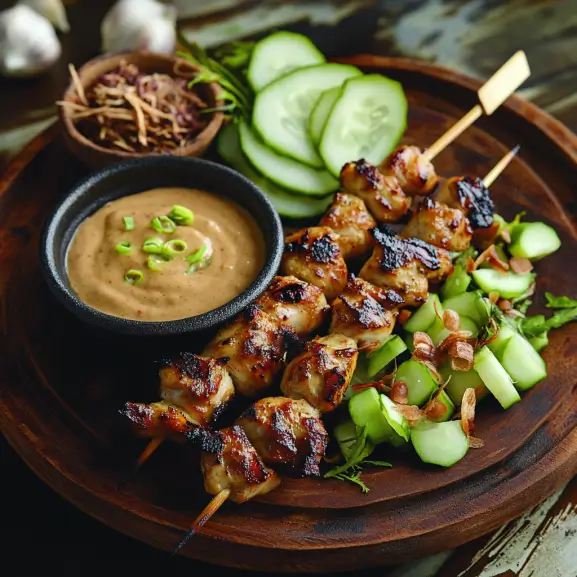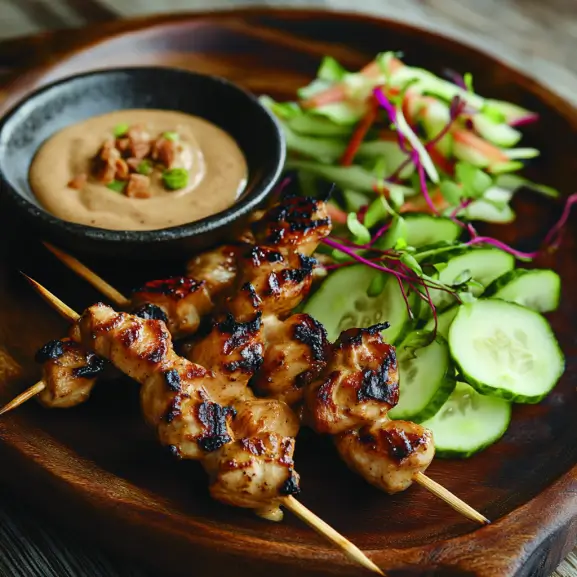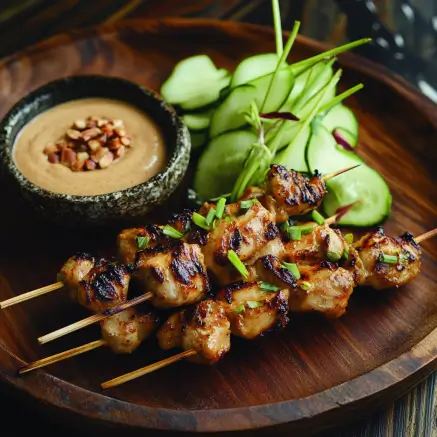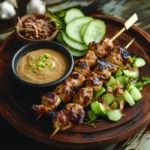Introduction :
The smell of grilled meat, the bright colours, and the exciting tastes of Asian street food grab your attention. From Bangkok’s busy night markets to Hong Kong’s lively alleys, Asia’s street food scene is rich and varied. Each dish tells a story of the area’s history and culture.
Get ready for a food adventure that takes you to the heart of Asia’s street food world. You might try the tender satay skewers in Malaysia or the crispy pork belly in Taiwan. The variety of Asian street meat is a feast for your senses.
We’ll explore the origins of this food and its cultural importance. We’ll also examine the different flavours and ingredients that make these dishes unique.

Key Takeaways
- Asian street meat offers a diverse array of grilled, skewered, braised, and fried specialities, each reflecting the unique culinary traditions of different regions.
- Street food markets serve as vibrant cultural hubs, providing affordable and authentic dining experiences for locals and travellers alike.
- Essential ingredients like soy sauce, lemongrass, fish sauce, and spice blends are the foundation of many Asian street meat dishes, creating bold and distinctive flavours.
- Culinary tourism is rising, with travellers seeking immersive food experiences that connect them to the local culture and traditions.
- Asian street food culture offers a sustainable and community-driven approach to cuisine, supporting local vendors and preserving culinary heritage.
What Is Asian Street Meat: Understanding the Tradition
Asia’s vibrant meat dishes represent a tradition defined by bold flavours and cultural significance. Street vendors offer expertly grilled, fried, and marinated meats, providing tasty and affordable options beloved by locals.
The Origins of Street Food Culture
Street food traditions across Asia trace back centuries. Markets were places where locals and travellers bonded over shared meals, blending food with the community.
The Role of Meat in Asian Street Cuisine
Meat is key in Asian cuisine, with each area having its unique cooking method. From the rich nihari stew of Pakistan to the aromatic chapli kebabs, the variety shows Asian culinary creativity.
Modern Evolution of Street Food
Today, traditional recipes meet modern tastes with healthier, vegan, and fusion options. Despite these changes, the essence of street cuisine remains rooted in heritage.

“The fusion of old recipes with modern culinary techniques allows for the reinvention of classic dishes in South Asian street food.”
The Cultural Significance of Street Food Markets in Asia
Step into Asia’s bustling street food markets, and you’ll find more than just food. You’ll discover a vibrant cultural tapestry. These markets are community gathering places where people bond over shared meals. They savour the flavours that define their local cuisine.
From the aromatic grilled Asian street meat of Thailand to the sizzling samosas of India, the diversity of dishes showcases the ingenuity and heritage of each region. These markets are more than just places to eat. They play a crucial role in the local economy, providing livelihoods for countless vendors and affordable sustenance for the community.
The atmosphere of these markets, with their captivating sights, sounds, and aromas, offers an authentic and immersive experience of Asian culture. It’s no wonder that street food markets have become iconic symbols of the region, cherished by locals and visitors alike.
“In the traditional town in Sri Lanka where I reside, meat and fish are predominantly sourced from markets, with rare sightings on supermarket shelves. Fruit and vegetables are often sold directly from the grower to the consumer, emphasizing a farm-to-table approach in the market setting.”
The significance of street food markets extends far beyond their culinary offerings. These vibrant hubs serve as cultural institutions, reflecting their respective communities’ traditions, social dynamics, and economic fabric. Whether savouring a skewer of Asian street meat or sipping on a refreshing beverage, visiting these markets promises an unforgettable exploration of Asia’s rich heritage.

In Sri Lanka, the author’s relocation near a Hindu temple led to restricted access to meat, fish, and alcohol, prompting a shift to purchasing fish at Jaffna’s best fish market on the seafront. This experience highlights the importance of markets in creating social hubs and purveying culture, reflecting their significance beyond just a shopping destination.
From Bangkok’s bustling night markets to Mumbai’s vibrant spice bazaars, these captivating street food destinations offer a window into Asia’s soul. Whether you’re a seasoned traveller or a curious foodie, immersing yourself in the energy and authenticity of these cultural epicentres is a must-do on any Asian adventure.
Popular Types of Meat Street Asian Delicacies
The world of Asian street food is full of tasty meat dishes. Each place has its unique dishes, from grilled to stewed. The flavours are amazing.
Grilled and Skewered Specialties
Try the smoky, juicy grilled and skewered meats. Enjoy Indonesian satay and meat on skewers with peanut sauce. Try Thai Moo Ping, juicy grilled pork skewers.
Also, don’t miss Japanese YYakitori, Which consists of small grilled chicken pieces with a savoury sauce.
Braised and Stewed Varieties
Explore the comforting braised and stewed meats. Try tender and flavorful Chinese braised pork belly. Don’t miss Filipino adobo, meat cooked in soy sauce, vinegar, and spices.
Fried and Crispy Options
Get ready for crispy fried meat. Try sweet and spicy Korean fried chicken. Enjoy Vietnamese egg rolls filled with meat and veggies.
Also, try Indian pakoras, crispy fritters with meat or veggies.
“The vibrant world of Asian street food offers a tantalizing array of meat-based delicacies, each region boasting its own iconic dishes.”
Regional Variations Across Asian Countries
The world of Asian street food reflects the continent’s vibrant culture, with each region showcasing its distinct flavours and cooking techniques. Let’s explore the unique tastes that make this culinary tradition so special.
Flavours of Southeast Asia
In Thailand and Indonesia, street meat is a mix of sweet, sour, salty, and spicy. Thai Moo Ping and Indonesian Satay have bold flavours. Vietnam’s Bo La Lot shows off fresh ingredients and different textures.
Precision in East Asia
In Japan and Korea, street meat is a work of art. Japanese Yakitori and Korean Bulgogi BBQ are known for their flavours. These cuisines focus on skill, presentation, and rich umami flavours.
Spice Blends of South Asia
In India and Pakistan, the smell of spices fills the air. South Asian street meat, like Seekh Kebabs, has complex spice blends that create a unique and memorable taste.
From Bangkok’s night markets to Tokyo’s alleys, Asian street meat is diverse. Discover the rich culture and traditions behind this beloved food.
Essential Ingredients and Cooking Techniques
Step-by-Step Recipe for Authentic Chicken Satay
Bring the authentic taste of Asian street meat to your kitchen with this simple yet flavorful chicken satay recipe.
Ingredients
- 500g chicken breast or thigh, cut into bite-sized pieces
- 2 tablespoons soy sauce
- 1 stalk lemongrass, finely chopped
- 3 cloves garlic, minced
- 1 tablespoon palm sugar
- 1 cup coconut milk
- Bamboo skewers (soaked in water for 30 minutes)
Instructions
- Prepare the Marinade: In a bowl, mix soy sauce, lemongrass, garlic, palm sugar, and coconut milk. Add the chicken pieces and coat them thoroughly. Cover and let marinate for at least 2 hours (overnight for best results).
- Skewer the Chicken: Thread the marinated chicken onto the soaked skewers.
- Grill the Skewers: Preheat your grill or grill pan. Cook the skewers on medium heat, turning every 2-3 minutes until the chicken is cooked through and slightly charred.
- Serve: Pair the satay with a side of peanut sauce and cucumber salad for a complete meal.
Variations to Try at Home
- Meat Alternatives: Swap chicken for beef, lamb, or even tofu for a vegetarian twist.
- Regional Twists: Use different marinades inspired by other regions, like a miso glaze for a Japanese twist or yoghurt-based marinade for an Indian flavour.
- Spice Levels: Adjust chilli or garlic quantities based on your heat preference.
Bringing Asian street meat into your kitchen is not only delicious but also a way to connect with the rich culinary heritage of Asia. Whether you’re hosting a barbecue or preparing a weeknight dinner, these flavours are sure to impress.
Street Meat Tips and Variations
Tips for Perfect Street Meat
- Marination is key: Allow your meat to soak in the marinade for at least two hours; overnight is even better for deep, complex flavours.
- Preheat Your Grill: Ensure your grill or pan is properly preheated to create a signature char and prevent sticking.
- Baste Regularly: Keep your meat juicy and flavorful by brushing it with extra marinade or glaze while cooking.
- Cut Meat Evenly: Cut your meat into uniform pieces for consistent cooking.
- Use Fresh Ingredients: Herbs, spices, and aromatics are crucial for authentic flavours.
Variations to Explore
Seafood Options: Shrimp, scallops, and squid work beautifully with Asian marinades and grilling techniques.
Vegan Alternatives: Substitute tofu, tempeh, or jackfruit for a plant-based option.
Fusion Twists: For a spicy-sweet twist, experiment with Korean gochujang in the marinade or use teriyaki for a Japanese-inspired flavour.
“The true essence of Asian street meat lies in the perfect marriage of time-honored traditions and innovative culinary experimentation.”
Health and Safety Considerations
Exploring Asian street meat Asia is exciting, but health and safety come first. The tempting Asian street meat dishes are a big draw, but knowing the risks is essential. Street vendors’ hygiene standards vary, so watching for proper food handling and cleanliness is key.
Many places have rules to make street food safer. Look for busy stalls and check how food is cooked. This way, you can enjoy Asian street meat Asia safely, thanks to some careful steps.
“The author has not had food poisoning since 2011 despite eating street food regularly.”
Long lines at stalls mean the food is fresh and safe. Eating at university areas during lunch is also a good idea. It’s cheaper, and the food is made for locals.
- Choose stalls with transparent kitchens where you can observe the food handling practices.
- Use detailed translation cards if you have any food allergies or restrictions.
- Be mindful of the cleanliness of cutlery, as it can be a source of bacteria, especially in urban centres.
- Start your day at morning markets to experience freshly cooked foods with quick turnover.
By being careful, you can enjoy Asian street meat without worrying about getting sick. The secret to a great Asian street meat experience is balancing fun with safety.
Street Food Economics: From Vendor to Customer
The Asian street meat industry is key to many Asian countries’ economies. It offers cheap meals and jobs for vendors, and its low prices make it easy for many to enjoy.
Pricing and Affordability
Worldwide, 1 in 4 people have tried street food in the last year. 55% of them go to asıan street meat stalls a few times a month. The reason? Street food is affordable, with 30% of dining choices influenced by cost.
Sustainable Practices
Some vendors are going green, using local ingredients and eco-friendly packaging. This helps the planet and supports local businesses. Sustainably sourced marine ingredients open new ideas in the Asian street meat market.
Economic Impact on Local Communities
The Asain Street Meat Industry boosts local economies, creating jobs and supporting small businesses. It also draws tourists looking for real local food. But vendors face challenges like discrimination and violence, which affect their work.
“International Day of Street Vendors is celebrated on 14 November to address the needs and challenges of street vendors.”
In places like Hanoi, Vietnam, many small shops join street vending. This adds to the area’s culture and income for vendors. It makes the community more lively and diverse.
Best Times and Places to Experience Street Meat
Discover the best times and places to enjoy Asian street meat. The city’s rhythm often sets the peak hours for these tasty treats.
At sunset, night markets in cities like Bangkok, Taipei, and Singapore buzz with life. They offer a wide range of street meat asian delights. Places like Yaowarat Road in Bangkok and Raohe Night Market in Taipei are must-visits for Asian street meat lovers.
Explore areas famous for meat street Asian scenes. Jalan Alor in Kuala Lumpur, Myeongdong in Seoul, and Tsukiji Outer Market in Tokyo are excellent spots. Each place has its own special street meat Asian vendors.
Timing is everything for the best Asian street food. Many cities host events or festivals for Asian street meat. The Chatuchak Weekend Market in Bangkok and Ben Thanh Market in Ho Chi Minh City are highlighted. These events let you taste Asia’s diverse flavours.
“The streets of Asia are a culinary playground, where the aroma of sizzling street meat asian beckons you to indulge in a flavorful adventure.”
Whether you’re at night markets or local food festivals, the best times are when the city is alive. This is when the meat street Asian culture shines.
Pairing Suggestions and Complementary Dishes
Asian street meat is a culinary delight often enhanced by pairing it with traditional side dishes and complementary beverages. Exploring these pairings can elevate your street food experience and provide a well-rounded meal.
Traditional Side Dishes
Accompany your Asian street meat with a variety of tantalizing side dishes. Popular options include:
- Pickled vegetables offer a refreshing contrast to the savoury meat
- Steamed rice, a classic base to soak up delicious sauces and juices
- Fresh herbs like cilantro, mint, or basil add vibrant flavours and aromas
Beverage Pairings
The perfect drink can complement the bold flavours of Asian street meat. Consider pairing it with:
- Thai iced tea, a creamy and sweet counterbalance to spicy Asian street meat
- Sake, a traditional Japanese rice wine that enhances the umami notes in Asian street meat
- Fresh fruit juices, such as mango or lychee, provide a refreshing contrast
Complete Meal Combinations
For a genuinely satisfying street food experience, build a complete meal by pairing your Asian street meet with complementary dishes. Some delicious options include:
- Vietnamese banh mi with a side of fresh spring rolls
- Korean bulgogi with kimchi and steamed rice
- Japanese yakitori skewers accompanied by edamame and miso soup
Street food vendors often offer set meals that combine the main dish, sides, and beverages, providing a well-rounded and convenient dining experience.
Modern Innovations in Street Food
The world of Asian street food is always changing. Vendors and entrepreneurs are adding new twists to old recipes, mixing local tastes with international flavours.
Fusion dishes are a big trend. They combine the familiar with the new. You might see Korean grill masters using Japanese umami or Thai spices in their asıan street meat skewers. Chinese steamed buns might have Indian or Mexican fillings, creating exciting flavour combinations.
There’s also a push for healthier Asian street meat options. Some stalls offer vegetarian or low-oil versions of classic dishes. Street food parks in cities like Singapore and Bangkok have stalls with organic produce and gluten-free options.
Technology is changing the Asian street meat Asia scene, too. Food delivery apps make it easy to get street food at home. Countries are also building street food hubs with better facilities and safety standards.
These changes keep Asian street food vibrant and relevant. From fusion flavours to healthier choices and tech advancements, the scene is constantly evolving. It offers a dynamic and tasty culinary journey for everyone.
“The secret to great street food is to never stop experimenting. It’s about honoring tradition while embracing the new.”
Conclusion
The world of asiastreetmeat is a flavorful journey through Asia’s diverse cultures. You can find everything from Bangkok’s meat street Asian markets to Tokyo’s street stalls. Each place offers a unique street meat Asian experience.
The bold flavours, affordable prices, and cultural significance make Asian street food unique. It’s a beloved part of Asia’s food heritage.
This culinary tradition continues to grow and remains a key part of Asian food identity. Whether you’re a local or a visitor, trying Asiastreetmeat is a real taste of Asia. It shows the region’s flavours, textures, and traditions.
As meat street Asian and street meat asian cuisine gets more popular, it lets us see into Asian culture. It invites us to enjoy and celebrate this fantastic food heritage.
In places like Katy Asian Town in Texas, you can find a wide range of Asian street meat. This area is a hub for diverse food, showing an appreciation for bold flavours and cultural significance. Exploring this scene takes you straight to Asia’s heart, one delicious bite at a time.
FAQ
What is Asian street meat?
Asian street meat is a feast for the senses. It combines sizzling meats, smoky smells, and bold tastes. This culinary tradition showcases the diversity of Asia through its many dishes.
What are the origins of Asian street food culture?
Asian street food has a long history. It started as a place for locals and travellers to meet. Today, street food markets are cultural centres that celebrate local traditions.
What is the role of meat in Asian street cuisine?
Meat is a big deal in Asian street food. Each area has its way of cooking meat, showing off local tastes and ingredients. From tender satay to crispy pork belly, there’s something for everyone.
How has street food evolved in Asia?
Street food has changed over time. Old recipes now meet new tastes, keeping their cultural roots. Vendors have added new twists, healthier choices, and tech to please today’s customers.
What are the health and safety considerations with Asian street meat?
Asian street food is tasty, but safety matters. Know about food storage, cooking temps, and stall cleanliness. Some places have rules to make street food safer.

A Flavorful Journey Through Asia’s Best Street Food: Asian Street Meat Asia
- Total Time: 30 minutes (plus marination time)
- Yield: 12 skewers 1x
Description
Explore Asian Street Meat, a journey through Asia’s best street food, rich in history, culture, and vibrant flavours.
Ingredients
For the Chicken Satay:
- 500g chicken breast or thighs, cut into bite-sized pieces
- 2 tablespoons soy sauce
- 1 stalk lemongrass, finely chopped
- 3 cloves garlic, minced
- 1 tablespoon palm sugar (or brown sugar)
- 1 cup coconut milk
- 1 teaspoon turmeric powder
- 1 teaspoon ground coriander
- Bamboo skewers, soaked in water for 30 minutes
For the Peanut Sauce:
- ½ cup creamy peanut butter
- 2 tablespoons soy sauce
- 1 tablespoon rice vinegar
- 1 tablespoon brown sugar
- 1 clove garlic, minced
- 1 teaspoon red curry paste
- ½ cup coconut milk
- 2 tablespoons water (to thin, if needed)
Instructions
Prepare the Marinade:
- In a mixing bowl, combine soy sauce, lemongrass, garlic, palm sugar, coconut milk, turmeric powder, and ground coriander. Mix well.
- Add the chicken pieces to the marinade, ensuring they are fully coated. Cover and refrigerate for at least 2 hours, preferably overnight for best results.
Prepare the Peanut Sauce:
- In a small saucepan over low heat, combine peanut butter, soy sauce, rice vinegar, brown sugar, garlic, red curry paste, and coconut milk. Stir until smooth and heated through. Add water to adjust consistency if needed. Set aside.
Skewer the Chicken:
- Thread the marinated chicken onto the soaked bamboo skewers.
Grill the Satay:
- Preheat your grill or grill pan to medium heat. Cook the chicken skewers for 3-4 minutes per side, turning frequently, until fully cooked and slightly charred.
Serve:
- Plate the chicken skewers and serve with warm peanut sauce on the side. Garnish with fresh cilantro and a wedge of lime for added flavor.
Notes
- Tips: For an extra smoky flavor, grill the skewers over charcoal.
- Variations: Swap chicken with shrimp, beef, or tofu for variety. Adjust the spice level by adding more red curry paste or chili flakes.
- Pairing Suggestions: Serve with cucumber salad, jasmine rice, or roti for a complete meal.
- Prep Time: 20 minutes (plus marination time)
- Cook Time: 10 minutes
- Category: Dinner
- Cuisine: Southeast Asian
Nutrition
- Serving Size: 4 servings
- Calories: 320 kcal
- Sodium: 560mg
- Fat: 18g
- Carbohydrates: 12g
- Protein: 25g
Keywords: Chicken satay, authentic satay recipe, grilled chicken skewers, peanut sauce, Asian street food, Thai chicken satay, easy satay recipe, marinated chicken, Southeast Asian cuisine, street food recipes.

1 thought on “A Flavorful Journey Through Asia’s Best Street Food: Asian Street Meat Asia”
Comments are closed.